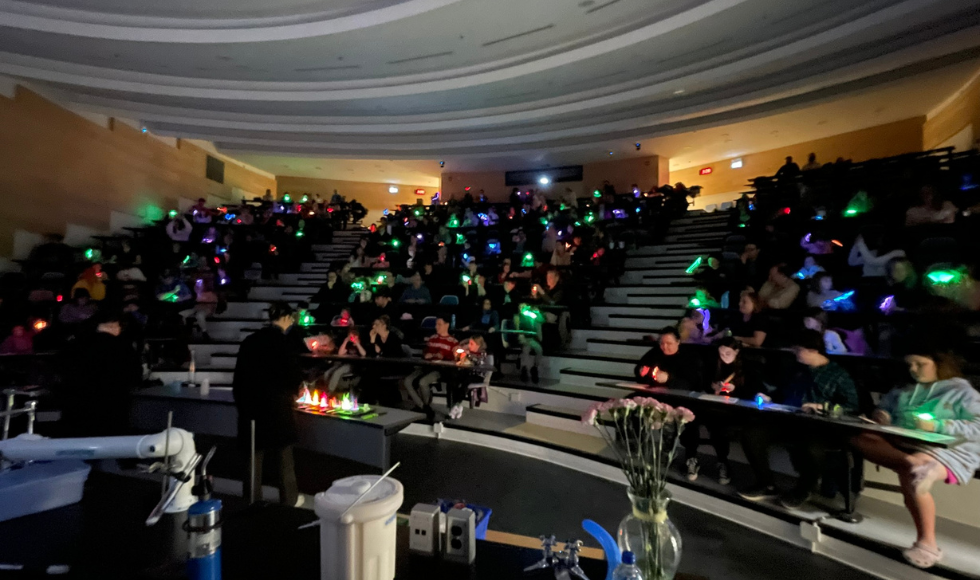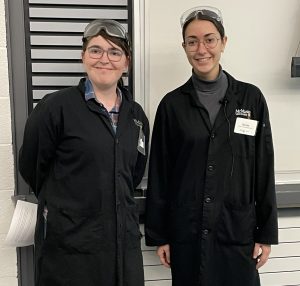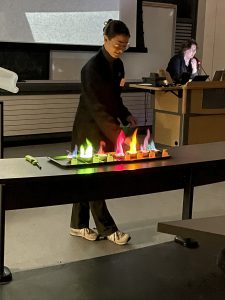Elephant toothpaste and flaming bowls: Undergrads wow the crowds

Chemistry and chemical biology students captivated more than 200 kids and grown-ups with an hour of flashes, bangs and chemical reactions at Magic of Molecules, an annual community event.
If you want to understand science, explain it to someone else.
But if you want to really understand science, explain it to a room packed with super-excited kids.
Undergrads Erin Donahue-Boyle and Nicole Malette aced that assignment, captivating more than 200 kids and grown-ups in a Burke Science Building lecture room with an hour of flashes, bangs and chemical reactions.
The Magic of Molecules is an annual community event run by students, faculty and staff in the department of Chemistry and Chemical Biology.

Donahue-Boyle and Malette were asked by their TA supervisor Rebecca Turner if they’d like to volunteer.
“I love anything to do with chemistry and I’m interested in teaching,” says Donahue-Boyle, a fourth-year sustainable chemistry student and Schulich Leader.
“This event seemed like a great combination of the two.”
Malette, a fourth-year chemical biology co-op student who’s worked as a summer camp counsellor and community counsellor, had the same reaction.
“It’s such a wonderful opportunity for kids to explore chemistry in a way that’s both fun and accessible. It was a real pleasure to be a part of the show.”

The students ran four crowd-pleasing chemistry demos that made magic out of science.
For the elephant toothpaste demo, Donahue-Boyle created an out-of-control geyser of bubbles by mixing dish soap with potassium iodide and hydrogen peroxide.
She also made a supersized glowstick using luminol. As the kids who went to the show can now tell you, luminol is an organic compound that emits light when oxidized.
With the spray sign demonstration, Malette showed how a secret message can be revealed on paper using iron-containing molecules.
She also ran a flaming bowls demo to show how different salts dissolved in methanol give off different colours of light while burning.
“My favourite part of Magic of Molecules was seeing how excited the audience got for every demonstration. Their reactions and their participation from start to finish was a big part of what made the event so successful and memorable for me.”
Donahue-Boyle also had a blast. “It’s easy to get disillusioned in the lab when nothing seems to be working.
“But when you hear the ‘oohs’ and ‘ahhs’ from the audience, you remember there’s a magical quality to chemistry.”
Event organizers make a point of giving starring roles to undergraduate and graduate students. It’s one way to ignite a lifelong passion for science communication, service and outreach, says associate professor Anthony Chibba. He’s been involved with the show since starting at McMaster in 2018.

“All the student volunteers we’ve had over the years have been awesome performers who put on a wonderful show,” he said.
“Nicole and Erin were amazing with their presentations and did an outstanding job of explaining the magic at just the right level for the kids in the audience. They were also incredibly helpful with the hands-on experiments that we get some of the kids in the audience to do, like making silver bottles or running an iodine clock race.”
Magic of Molecules is a great way to promote chemistry to future generations of scientists, says Malette.
“Outreach projects can foster a curiosity and love for science in students at a young age. It’s a great way to make a lasting impression.”
Donahue-Boyle says fostering that curiosity should be in the job description for every scientist. “We have a responsibility to share what we do with others and talk about our research in ways that different audiences can easily understand.
“Plus, it’s a ton of fun.”


